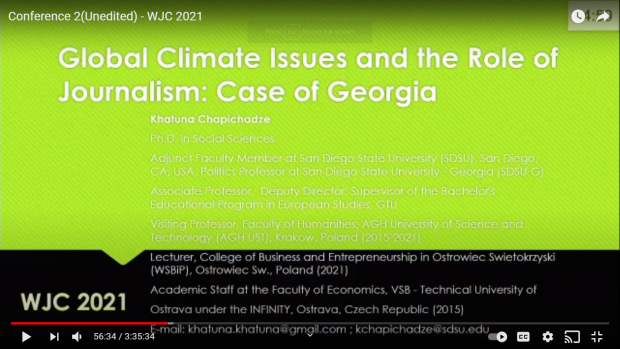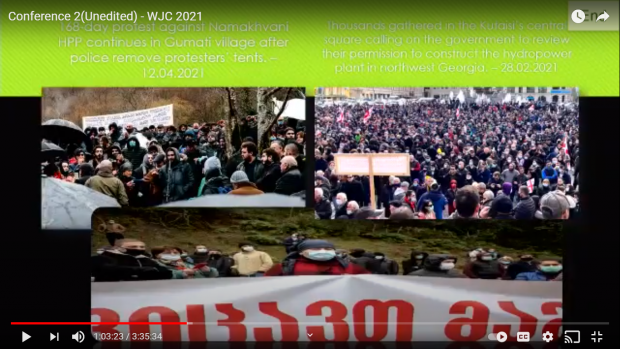Global Climate Issues and the Role of Journalism: Case of Georgia

By Khatuna Chapichadze
Georgian Technical University
San Diego State University Professor
TBILISI: The World Journalists Conference (WJC), organized by the Journalists Association of Korea (JAK) annually, was conducted from Monday, April 19 to Tuesday, April 20, 2021, online for the second time in its history – due to the continuing global pandemic – COVID-19.
On Tuesday, April 20, during the 2nd day of the WJC 2021, in which around 70 journalists and other media and non-media professionals participated from about 50 countries in total, in relevance to the conference session topic, along with other 21 colleagues, I gave the following speech, addressing quite critical cases in Georgia, while discussing the global climate issues and the role of journalism:
“Introduction
According to the National Report on the State of the Environment of Georgia (2014-2017), concerning the question about the trends of GHG emissions in recent years in the country, the document states: “Georgia’s total GHG emissions in 2015 amounted to about 17,589,000 tonnes of CO2 eq., 62% of which were from the energy sector, and 38% for non-energy related GHG emissions, comprising 18% of the agricultural sector, 12% of industry sector and the waste sector – 8%. The average annual increase in GHG emissions for the period of 2010-2015 is 6.3%.”
Based on the same report, as a result of climate change in Georgia, the average annual temperature during the period of 1961-2010 has been increasing. During this period, the average annual temperature increased by 0.4-0.50C. The highest trend of increase in temperature was observed in Dedoplistskaro (Kakheti, eastern Georgia) (0.70C) and Poti (Samegrelo-Zemo Svaneti, western Georgia) (0.60C). In the period of 1961-2010, the annual precipitation in western Georgia increased by 5%, while in eastern Georgia it decreased by 0.1%. The highest – 14% increase was observed in the lowlands of Svaneti (north-western Georgia) and the Adjara highlands (south-western Georgia), with the highest decrease in the central part of the Likhi Range (central Georgia) – 8% and in Meskheti (a mountainous area in south-western Georgia) 6%.
Regarding the obligations that Georgia has assumed under the Paris Agreement, and on the significance of the Paris Agreement per se for the country, the above-mentioned document emphasizes that by joining the Paris Agreement, Georgia has promised to limit emissions on its territory by an unconditional 15% compared to the baseline level (traditional business development scenario), and to increase its commitment of the limitation to 25% in case of international support. In order to reduce the climate change related risks, Georgia should maintain and strengthen the access to the resources of international foundations and various partner organizations, as well as adopt the new Market Mechanism under the convention allowing Georgia to introduce progressive, future technologies, which would aim at the reduction of the GHG emissions and increase of the adaptation potential for the country, along with spurring economic development through the production of sustainable, environmentally friendly products, green job creation, and poverty reduction.
For illustrating the most challenging environmental issues faced by Georgia and showing the role of the homogenic factors contributing to the climate change in the country, let’s discuss two major and greatly controversial projects: Khudoni Hydropower Plant (Khudoni HPP) and Namakhvani Hydroelectric Power Plant (Namakhvani HPP).

Khudoni Hydropower Plant
Key facts
Size and costs: With the planned 200.5 meter-tall arch dam, an underground powerhouse, and a 528 hectare water reservoir the Khudoni HPP in Svaneti would become the second largest hydropower plant in Georgia. The costs have been estimated at EUR 1.06 billion (GEL 2.75 billion). Feasibility: The project requires the resettlement of 2000 people, which will negatively affect cultural heritage and will not bring significant tax revenues for Georgia. The positive conclusions of a feasibility study on Khudoni’s technical and financial viability are being questioned by observers, as well as local communities. Promoter & financiers: The project company’s beneficial owners are unknown, as are the financiers of the project. (The World Bank provided technical assistance for the feasibility study.) The Georgian state provided 24 percent of the project costs, without receiving a share in the project company or similar compensation.
Key issues
- About 2000 locals to be displaced by the dam. Their fierce opposition has triggered a nation-wide discussion about Khudoni.
- Government responds with a certain degree of intimidation and PR campaigns.
- Project’s benefits for Georgia’s public are very limited with low taxation and the project company registered offshore.
- Project likely to have adverse impacts on water streams, local culture and geological stability. (CEE Bankwatch Network)
Namakhvani Hydroelectric Power Plant
Key facts
The investment cost of the project is $800 million. The Turkish company Enka Riniebels Ltd plans to build a hydroelectric power station in western Georgia, in the Rioni River gorge, in the municipalities of Tskaltubo and Tsageri.
The Namakhvani HPP cascade includes two HPPs – Tvishi-HPP with an installed capacity of 100 MW, which will be 60 meters high, and Namakhvani-Joneti with an installed capacity of 333 MW, which will be 111 meters. The total capacity is 433 MW. Annual output is 1,500 GWh.
Key issues
- Geological and seismic risks, landslide hazards and expected microclimatic changes are the main concerns and subject of constant protest of the population, specialists and civil society, which, in general, creates the expectation of deteriorated ecological and socio-economic situation. (Public Defender (Ombudsman) of Georgia)
- The hydroelectric power station would completely flood the valley and endanger the existence of 18 villages. Therefore, local residents call the project “the dam of death” (JAMnews).
- The dam will stand just a few kilometers from the second largest city in Georgia, Kutaisi. If the dam is damaged, a 34-meter wave could reach the city in 19 minutes.
- The lack of the thoroughness of the examination of all aspects of the environmental impact. Still an environmental impact report states that the implementation of the Nizhni Namakhvani project alone will sacrifice a large amount of arable land, five villages will be flooded, and about three hundred families will be relocated.
- The conduct of the public hearing of the report on the project’s environmental impact has also been problematic.
- According to experts of the organization Green Alternative, Namakhvani will not withstand an earthquake even with a magnitude of 5 points. Meanwhile, a few kilometers from the city, in the Racha region, in 1991 there was a magnitude-7 earthquake.
- The hydroelectric power station will also change the culture of the region – tourism, cultural heritage, winemaking, etc.
- The economic-energy usefulness of the project is questionable as well.
The Role of Journalists
Particularly besides the CEE Bankwatch Network – one of the largest networks of environmental NGOs operating in the Central and Eastern Europe, which keeps providing deep insights about the most topical environmental issues persisting in Georgia, as well as in the whole CEE region, there are still a few, however increasing number of diverse media outlets like JAMnews, Mtisambebi.ge, Civil.ge, Open Caucasus Media (OC Media), etc. working in Georgia and beyond its borders that are especially active in critically covering these problems. Currently, similarly to the anti-Khudoni protests raging years ago, the major attention has been focused towards the planned construction of another hugely controversial Namakhvani HPP due to the ongoing fierce again, and significantly massive protests uniting not only locals, but thousands of others as well who are joining from different parts of Georgia.”










































